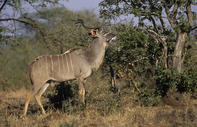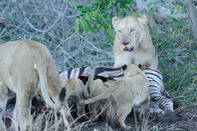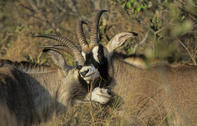Inspection and Maintenance
James Stevenson-Hamilton, one of the first Kruger Park wardens, developed a regular routine of inspection and maintenance to keep his reserve in order. It was, as he describes it in South African Eden, a very pleasant task; part colonial safari and part adventurous expedition.

Indeed, when describing this annual odyssey, Stevenson-Hamilton often speaks as if he is a country lord making a tour of his estate, which in many respects is exactly what he was. “For my part, I gradually fell into a more or less regular annual routine. About mid-May, the rain was practically over for the season, and it became possible to camp with a reasonable likelihood of keeping dry.
Since, however, there was still plenty of water remaining in the veld, this was the most suitable time of year in which to explore, with the aid of pack donkeys, the drier portions of the Reserve between the Sabi and the Crocodile Rivers.” - From James Stevenson-Hamilton’s South African Eden.
Tormented by Lions

When James Stevenson-Hamilton first arrived in the Sabi Reserve, his priority was to bolster the numbers of antelope and other large grazers, as these were the most popular animals to hunt. The carnivorous predators were therefore seen as a threat to the reserve and not an asset. Furthermore, it was deemed that the numbers of Carnivora were too high when compared to the decimated herbivorous herds.
The only solution was to shoot as many of the meat-eaters as possible. This may sound amazing today when these noble predators are considered to be the stars of the wildlife experience. However, back then, lions were seen as dangerous and useless creatures. Early farmers and settlers were constantly tormented by lions, which used to hunt freely throughout Southern Africa.
In the Lowveld, this fear verged on hysteria and, throughout the first (unfenced) decades of the park’s existence, local farmers complained bitterly that the unpopular Sabi Reserve was nothing more than a breeding ground for hungry killers that attacked their cattle and stalked their children.
The Culling Policy

For these reasons, the warden and his rangers followed a committed policy of Carnivora culling. Lions, wild dog, leopard, cheetah and crocs were all shot as part of every ranger’s daily activities. In this way, it was thought, the balance of nature would be encouraged to restore itself, and the neighbouring farmers would be placated. Stevenson-Hamilton even recounted several proud stories in which he stalked a vicious beast through the bush and triumphantly shot it down, just like the stereotypical great white hunter he so despised.
The culling policy was severely misguided. Nature restores itself best when left more or less alone. Nevertheless, the policy remained in force until the reserve became a National Park in 1926. The reason for this about-face was that the tourists couldn’t get enough of the lions and would not have tolerated their destruction. Still, the lion culling campaign was resurrected by the Kruger National Park research department during the drought years of 1953 to 1958.
By David Fleminger African elephant or African bush elephant (loxodonta africana). With a weight on 7 tonnes and a height that can reach 3.3 m to the shoulder,...
African elephant or African bush elephant (loxodonta africana). With a weight on 7 tonnes and a height that can reach 3.3 m to the shoulder,... In the 1800s, game was seen as a commodity, to be exploited for commercial gain. In the early 1900s, attitudes became more romantic, thanks ...
In the 1800s, game was seen as a commodity, to be exploited for commercial gain. In the early 1900s, attitudes became more romantic, thanks ...